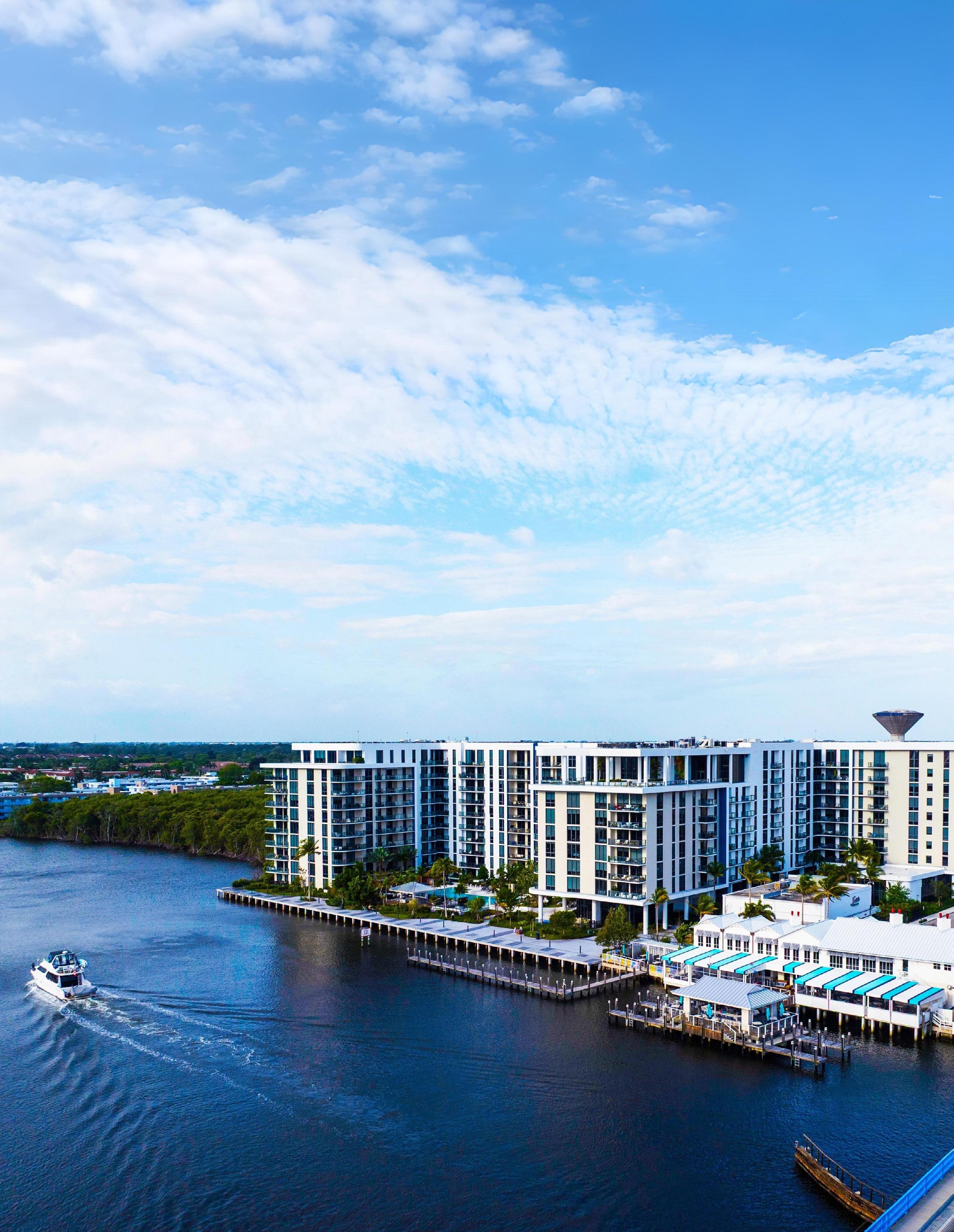

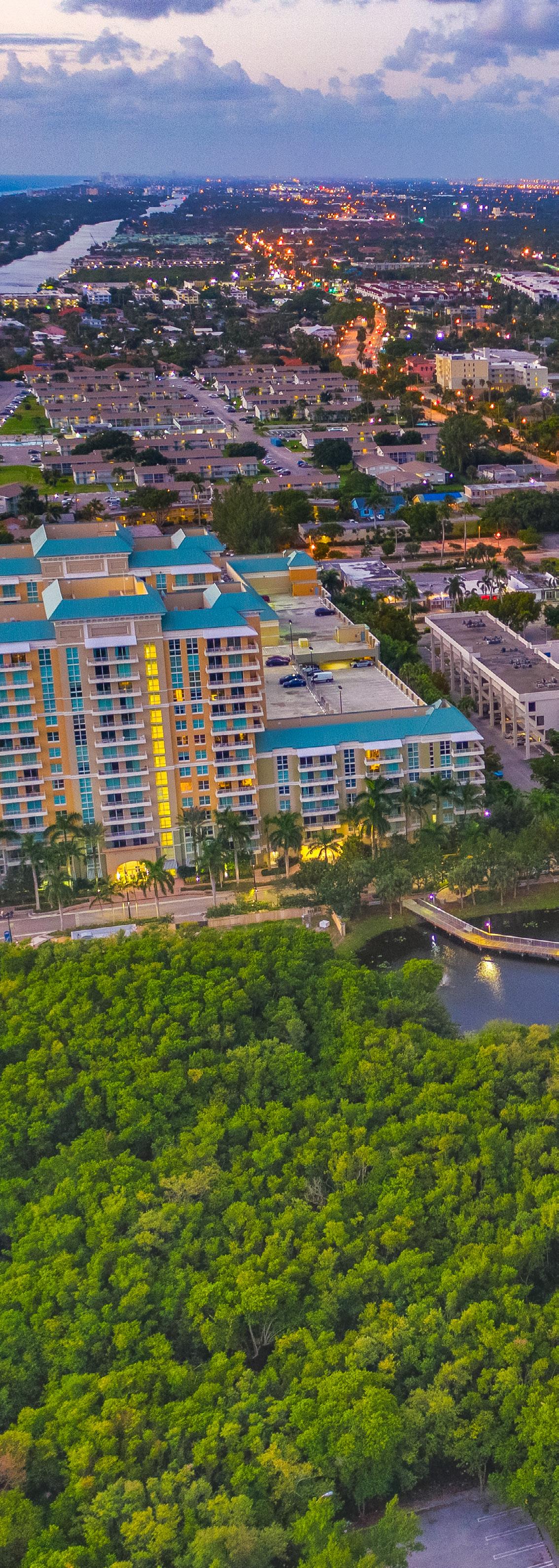







Boynton Beach stands at a transformative crossroads. With a population that has grown by over 20% since 2010—outpacing the county average—and a diverse, youthful community where more than 60% of residents are under 50, the City is fast emerging as South Florida’s next hub for innovation, livability, and inclusive economic growth. Anchored by its prime coastal location, strong regional connectivity, and rich cultural diversity, Boynton Beach is uniquely positioned to capture new investment, foster entrepreneurship, and elevate quality of life for all who live and work here.
This five-year Economic Development Plan charts a bold, actionable course designed to harness this momentum and guide Boynton Beach into its next era of prosperity. Rooted in rigorous demographic and market analysis, the plan integrates insights from multiple research sources—including a 2023 analytical assessment by Florida International University (FIU) and a 2024 real estate and economic snapshot by WGI. These studies highlight critical trends such as shifting workforce dynamics, rising demand for walkable mixed-use districts, and rapid growth in key business sectors like healthcare, hospitality, and technology.
Boynton Beach’s economic landscape is shaped by transformational trends: accelerated online commerce, evolving lifestyle expectations, and intensifying competition among cities to attract and retain businesses and skilled talent. The City’s increasing diversity—nearly half of residents identify as Hispanic, Black, or multiracial—combined with a thriving entrepreneurial spirit and access to coastal and urban amenities, positions Boynton Beach as a prime destination for innovative industries and small business growth.
This plan is structured around five interconnected principles, each designed to advance the City’s long-term vision and support three aspirational goals:
Downtown & Waterfront Reinvestment — Elevating civic and coastal assets as powerful economic catalysts.
Business Attraction & Retention — Strengthening the foundation for local enterprises and target industries.
Workforce Development & Housing — Building pathways to prosperity through skills development, opportunity creation, and housing affordability.
Economic Development
Marketing — Telling Boynton Beach’s story with clarity, consistency, and confidence to drive investment and engagement.
Placemaking — Creating distinctive, connected districts that enhance community identity and economic vitality.
To establish Boynton Beach as a regional hub for innovation and economic opportunity.
To become a livable city with vibrant districts, inclusive housing options, and a skilled workforce.
To foster a collaborative, equitable community that values partnerships and shared prosperity.
As defined by the International Economic Development Council, economic development is the intentional practice of improving a community’s economic wellbeing and quality of life—through job growth, business support, capital attraction, and creating the conditions in which people and enterprises can thrive. For Boynton Beach, this also means reflecting the energy, talent, and diversity of its residents in every initiative and outcome.
This plan is not a static roadmap but a dynamic, living document designed to adapt to new challenges and opportunities. It calls for coordinated action and sustained collaboration among public, private, and community partners, transforming shared vision into measurable and inclusive results.
Boynton Beach is ready to lead. By advancing this plan, we will secure a future that is economically resilient, socially inclusive, and vibrantly connected. We invite residents, businesses, and stakeholders to join us in shaping this next chapter— together turning ambition into action, and potential into lasting prosperity.

This plan is anchored in a strategic model that reflects a long-term vision for sustainable and inclusive growth. It is built on a set of guiding principles that shape the City’s approach to economic development, supported by targeted tactics designed to be implemented over the next five years. These principles reflect Boynton Beach’s commitment to fostering innovation, attracting investment, and enhancing the overall quality of life for residents and businesses. The vision and mission of the plan serve as the foundation for this model, ensuring that all economic development activities are aligned with the City’s core values and aspirations for the future.
This strategic model is built on guiding principles that are activated through targeted strategies. These components serve as the foundation for economic development efforts over the next five years. While the initiatives provide a clear direction, they are also designed to adapt—responding to new challenges, emerging opportunities, and community input as the City progresses.
Rather than a static plan, this model encourages continuous collaboration and shared accountability. It brings together a network of partners—across sectors and industries—who contribute to a unified vision for Boynton Beach’s economic future. Through alignment, coordination, and ongoing evaluation, this approach transforms vision into measurable, inclusive outcomes.
Boynton Beach is a dynamic City where sustainable economic growth drives innovation, attracts investment, empowers businesses, and creates lasting prosperity for all.
To cultivate a thriving economic ecosystem through innovative development initiatives that attract investment, support local enterprises, and expand regional impact while creating growth opportunities for residents and leveraging the city’s unique assets.

Boynton Beach will enhance its Downtown and Waterfront Areas as vibrant, connected destinations that support economic growth, tourism, and community life. This includes advancing Town Square as the city’s civic and cultural hub, encouraging high-quality mixed-use development, expanding waterfront dining and recreation, and improving walkability and connectivity between key areas.
The Downtown Marina District, home to nearly 9,000 residents and over 160 business establishments, already serves as a dynamic live–work–play environment with bikeable and walkable access to the beach, restaurants, parks, transit, and cultural experiences. With over 1,100 jobs, this district plays a vital role in the city’s economic fabric and offers significant potential for growth. New mixed-use development in this area should prioritize housing that accommodates residents of all ages and incomes, while also supporting entrepreneurial activity, job creation, and public space activation.
The Boynton Harbor Marina has become a tourism destination and remains a key recreational and economic anchor for the city. By preserving its working waterfront and supporting the local boating community, the city can further leverage this unique asset to enhance coastal access, attract visitors, and stimulate adjacent business growth.
To fully realize the potential of the Downtown Marina District, the City will:
■ Continue prioritizing vibrancy and placemaking to ensure the district remains a destinationdriver;
■ Expand the vibrancy and energy of the Downtown into neighboring districts and emerging micro-districts;
■ Promote housing affordability and accessibility through mixed-use development that supports economic mobility and inclusive growth.
Complementary efforts will include enhancing coastal connections and integrating infrastructure improvements that create a cohesive and welcoming environment from downtown to the shoreline.
1. Support the development of Town Square as the central civic destination of the city
1.1. Develop a phased improvement plan for Town Square that includes enhanced landscaping and curated public art to create an inviting public realm, improve aesthetics, and encourage community use.
1.2. Leverage partnerships to expand civic events, cultural programming, and communitybased markets in Town Square.
2. Support and incentivize the mixed-use development of downtown.
2.1. Promote and establish public-private partnerships to catalyze infill development on underutilized city or CRA-owned parcels.
2.2. Establish zoning overlays and incentives to support mixed-use development and attract local businesses to ground-floor spaces.
2.3. Implement proactive outreach to developers for key opportunity sites through design guidelines and streamlined approvals.
3. Expand dining, retail, and hospitality along the waterfront and beach-adjacent corridors.
3.1. Identify and market priority sites along the waterfront for dining, retail, and boutique lodging, supported by fast-track permitting and clear design guidelines.
3.2. Establish a hospitality recruitment strategy for infrastructure upgrades and funding to support expanded uses.
3.3. Explore seasonal beach events or pop-up amenities (e.g., beach markets or recreational rentals) to increase economic activity east of the bridge.
4. Improve connections between downtown, the waterfront and other key assets to strengthen economic identity.
4.1. Conduct a walkability audit to prioritize pedestrian improvements and streetscape upgrades.
4.2. Implement phased enhancements including signage, decorative lighting, and safe crossings to connect civic, commercial, and recreational nodes.
4.3. Install branded district signage and integrate connectivity improvements into capital projects and development plans.
5. Review opportunities to enhance the Boynton Beach Marina and associated uses.
5.1. Engage stakeholders and explore public-private partnerships to fund marina upgrades and enhance commercial or recreational offerings.
5.2. Propose a phased expansion plan aligned with broader waterfront revitalization goals and surrounding land use strategies.
1. Number of net new businesses operating downtown and along waterfront corridors
2. Increase in residential units within the downtown/waterfront districts
3. Amount of redevelopment funds invested to enhance downtown’s public spaces/attractiveness
4. Annual number of visitors to Town Square, the Marina, and beach-adjacent commercial zones
As Boynton Beach looks to the future, proactively targeting key industry sectors can help expand the city’s industry and employment composition while preserving the attributes and characteristics that have led to the city’s economic development success. The following industries may be particularly suitable for expanded growth in Boynton Beach. This list of relevant target areas was developed based on the findings in this economic profile including a high local competitive advantage as identified by its location quotient, stable positive employment growth, and national industry trends.
■ Hospitality (Accommodation and Food Services)
■ Professional, Scientific, and Technical Services
■ Construction
■ Small Business Incubation
■ Health Care and Social Assistance
Boynton Beach’s top five industry sectors include retailers (12%), service-oriented businesses (11.5%), health care and social assistance establishments (10.7%), companies that offer professional, scientific, and technical services (10.2%), and construction companies (7.2%).
¹ Other services include the repair and maintenance industry; personal and laundry services; religious, grantmaking, civic, professional, and similar organizations, and employed workers such as gardeners, caretakers, and other maintenance workers.
2 Unclassified establishments defined as businesses yet to report a designated NAICS code, often newer businesses
Data Source: Esri Business Analyst, Data Axle
Boynton Beach is committed to cultivating a dynamic business environment that attracts innovative industries, supports local entrepreneurs, and drives inclusive economic growth. By aligning targeted incentives, fostering entrepreneurship, and leveraging key commercial corridors for industry clustering, the City will strengthen its competitive edge, create quality jobs, and enhance long-term economic resilience.
1. Attract and expand key industries that drive economic growth and create quality jobs.
1.1. Focus on life science, technology, marine industries, creative industries, and sustainable tourism to align with the city’s key assets.
1.2. Identify commercial corridors suitable for mixed-use development and targeted industry expansion.
1.3. Create marketing collateral tailored to business attraction in identified sectors.
2. Develop targeted incentive programs to support industry expansion and small business growth.
2.1. Increase the availability and scope of grant programs for local businesses.
2.2. Develop a platform for matching small businesses with grants and capital, such as online matching services, lender referrals, and loan products.
2.3. Leverage Placer.ai Data driven metrics for programs and incentives
3. Create incentives to attract high-impact, targeted industry businesses.
3.1. Implement streamlined permitting processes for qualified business projects.
3.2. Develop an incentive framework designed for high-growth businesses in priority sectors.
4. Foster entrepreneurship and industry engagement through business-friendly policies and programs.
4.1. Establish recurring Industry and Stakeholder Roundtables to facilitate collaboration, innovation, and technology exchange.
4.2. Facilitate mentorship opportunities, peer learning, and resource-sharing networks among local entrepreneurs and business leaders.
5. Strengthen industry hubs to encourage clustering and synergy.
5.1. Identify and map emerging business hubs across the City that align with targeted industry sectors.
5.2. Build and expand public-private partnerships that support industrial strategy, shared infrastructure, and business ecosystems.
1. Number of incentives or grants awarded
2. Average number of days for permit approval
3. Business Inquiries or leads generated
4. Number of Entrepreneurs Supported through Programs, Workshops, or Funding Access
5. Job Creation in Targeted Industries
To build a resilient and inclusive economy, Boynton Beach will invest in developing a skilled workforce while expanding access to diverse and attainable housing options. This dual focus ensures that residents not only have the tools and training to succeed in the local job market but also the opportunity to live and thrive in the community they support.
Strategic partnerships with employers, educators, and workforce organizations will be central to aligning talent development with the needs of high-growth sectors. At the same time, the City will promote smart, equitable housing strategies to attract and retain workers, support economic mobility, and enhance neighborhood stability.
Boynton Beach is experiencing strong employment momentum. As of 2024, the city supported over 38,800 private-sector jobs, marking a 5.6% year-over-year employment growth—the highest among peer cities in the region. This growth added nearly 2,000 jobs within city limits, underscoring Boynton’s emerging role as an employment hub.
Data Source: Esri Business Analyst, Data Axle
Notably, the city is anchored by a robust small business ecosystem, with an average of eight employees per establishment—well below the state and national averages—signaling a dynamic, entrepreneurial economy. Nearly half of all private-sector employment is concentrated in healthcare, retail, and accommodation/food services, reflecting both the city’s core industries and service-oriented economy.
To sustain and accelerate this growth, workforce development strategies must prioritize skills-based training and pathways that align with target industries, such as advanced manufacturing, health care, and professional services. Expanding apprenticeships, high school career exploration, and industry certifications will build a steady talent pipeline. Equally important is addressing barriers to workforce participation by investing in wraparound services—such as childcare, transportation, and tuition support—to ensure equitable access to opportunity.
Population growth in Boynton Beach continues to outpace regional peers, with the city adding over 14,000 residents between 2010 and 2024—a 20.1% increase, outpacing Palm Beach County and most comparison cities. This growth creates both opportunities and pressure on the local housing market.
Data Source: Esri Business Analyst, U.S. Census Bureau
As of mid-2024, the city’s median home sales price reached $414,700, reflecting a 6.5% year-overyear increase—the highest among nearby municipalities. While rising inventory and cooling sales suggest a transition toward a more balanced market, affordability remains a significant concern.
Data Source: Rocket Homes, August 2024
Multifamily housing indicators show a 7.4% vacancy rate and a stabilized rent average of $2,205 per unit, suggesting steady demand. Yet, a substantial portion of residents—both renters and homeowners—remain cost-burdened. The City’s Housing and Transportation (H+T) Index exceeds the recommended affordability threshold, highlighting the need for integrated solutions.

Data Source: CoStar, August 2024
To address these challenges, Boynton Beach will adopt a proactive approach that includes a comprehensive housing strategy focused not only on increasing supply but also on supporting upward mobility and neighborhood diversity. Ensuring a balance of housing types and price points will enable the City to meet the needs of its growing population and support a sustainable, inclusive economy.

Together, workforce development and housing form the foundation of Boynton Beach’s long-term economic resilience. A well-trained workforce must be matched with access to attainable, stable housing to ensure that residents can live where they work, grow in their careers, and contribute meaningfully to the community. By aligning education, employment, and housing strategies, the City will create a more inclusive, competitive, and sustainable future—where economic opportunity is accessible to all.
Data Source: CoStar, August 2024
1. Build a Skilled Workforce through Strategic Education and Training Partnerships
1.1. Conduct an inventory and assessment of agencies, organizations, and partners engaged in workforce development.
1.2. Strengthen relationships with institutions and economic development partners that offer workforce-related services, certifications, and upskilling programs.
2. Align workforce training with local industry needs to create career pathways, ensuring talent attraction, job stability, and economic mobility.
2.1. Facilitate partnerships between Boynton Beach High School and industry leaders to expand apprenticeships, internships, and career exposure.
2.2. Support the development of targeted training programs in high-demand and advanced industry sectors to grow a skilled local talent pipeline.
3. Expand housing options to support workforce retention and attraction.
3.1. Develop a comprehensive Housing Affordability Strategy that identifies needs, challenges, and actionable solutions.
3.2. Align zoning, planning, and infrastructure strategies to support a diverse mix of housing types for all income levels.
4. Incentivize mixed-income developments, workforce housing, and homeownership programs to maintain an accessible housing market.
4.1. Promote policies that encourage the development of mixed-income and workforce housing through density bonuses, expedited permitting, or financial incentives
4.2. Expand homeownership assistance programs such as down payment support and financial counseling for moderate-income residents.
5. Promote Talent Retention through Mobility and Support Services
5.1. Partner with local organizations to offer wraparound support services, including childcare, financial literacy, and transportation assistance.
5.2. Identify and address barriers to workforce participation through targeted community engagement and needs assessments.
1. Percent of city residents working in the city
2. Enrollment or participation in workforce training programs
3. Amount of public funds allocated toward affordable/workforce housing
4. Number of partnerships developed/created
5. Number of new mixed-income or workforce housing units initiated or completed
Strategic placemaking plays a critical role in shaping Boynton Beach’s economic future by enhancing the physical, cultural, and social fabric of the city. By focusing on targeted improvements to public spaces, infrastructure, connectivity, and branding, the City aims to reinforce the identity of its distinct districts—particularly the Economic Target Areas (ETAs) and CRA Districts—as vibrant, walkable hubs for commerce, culture, and coastal lifestyle. These efforts contribute directly to a higher quality of life for residents, attract visitors, and elevate Boynton Beach’s competitiveness as a destination for business, investment, and talent.
Creating districts that are inviting, well-maintained, and visually distinct is central to economic vitality. Areas that exhibit strong placemaking characteristics tend to attract new businesses, increase customer traffic, spark reinvestment, and support employment growth. While placemaking outcomes often rely on physical interventions, their success is equally rooted in perception—how people experience and identify with a place.
Boynton Beach’s Citywide Placemaking Strategy directs programs and resources to seven Economic Target Areas (ETAs) identified through the Competitive Assessment conducted by Florida International University. These ETAs reflect the diversity of Boynton Beach’s commercial landscape, offering unique combinations of retail types, customer bases, and geographic orientation that collectively define the city’s retail economy. Notably, the Congress Avenue and Highridge TOD districts—Boynton’s two largest by land area—house the majority of the city’s retail-oriented businesses, followed closely by the Downtown Marina District. While the Downtown Marina and Congress Avenue districts hold the greatest concentration of restaurants, GAFO (general apparel, furnishings, and other) retailers are most prevalent along Woolbright Road and Congress Avenue. Most districts remain oriented toward neighborhood goods and services.
In addition to the ETAs, the City’s Economic Development Division has identified two supplemental districts—Four Corners and The Beach—as high-potential zones essential to the city’s long-term economic success. These layover districts, though not formally designated ETAs, will be integrated into the placemaking strategy due to their strategic location, community value, and potential to contribute to citywide prosperity.
Establishing a clear and authentic identity for each district is foundational to placemaking success. A district’s identity can emerge from a combination of visual branding, historic or cultural context, predominant industries, or its role within the broader city ecosystem. This identity should inform everything from signage and urban design to programming and business attraction strategies—ensuring a cohesive sense of place that resonates with both residents and visitors.
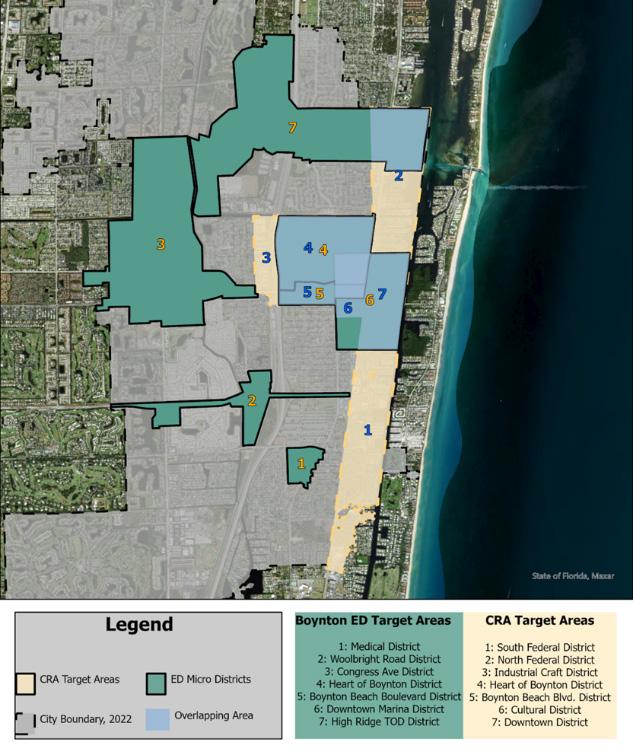
Significant Existing Efforts:
Some Existing Efforts:
No Existing Efforts:
Image & Perceptions
1. Identify key districts to enhance economic activity through branding and placemaking strategies to incentivize business clusters.
1.1. Expand placemaking investment in the CRA Districts and Economic Target Areas.
1.2. Perform a business inventory of the city’s Light Industrial (MI) and Planned Industrial Development (PID) zones to better understand industries occupying industrial space and the products they manufacture and/or distribute to better market what is produced in the CIty.
2. Invest in public spaces, infrastructure, and urban design to foster a vibrant business environment.
2.1. Adopt guiding design principles for the Economic Target Areas that promote investment activity that is functional, aesthetic, and compatible with the surrounding community.
2.2. Adopt guiding design standards for key commercial corridors reflective of urban design concepts and streetscape improvements that support high-quality corridors for both the vehicular and pedestrian experience
3. Increase walkability and connectivity to support business growth and community engagement.
3.1. Create a Citywide Pedestrian and Bicycle Connectivity Plan Map and implement safe, attractive walking and biking routes that connect Economic Target Areas, CRA districts, beach access points, parks, and commercial corridors.
3.2. Activate Alleyways and Underutilized Streets with pedestrian-friendly shared spaces through temporary or permanent placemaking interventions like murals, lighting, string lights
4. Expand lifestyle amenities that enhance the City’s appeal and overall quality of life.
4.1. Develop a Coastal Placemaking Plan to enhance beach access points with amenities like branded signage, sculptural bike racks, dune boardwalks, coastal-themed art, and shaded seating.
4.2. Launch a Year-Round Events Calendar in Key Districts with seasonal cultural, wellness, and culinary events in Economic Target Areas to activate public spaces, attract new visitors, and support local businesses.
5. Implement district-specific signage to establish and promote key placemaking areas, reinforcing identity and guiding visitors to business and cultural hubs
5.1. Invest in gateways and key entry points into Boynton Beach to continue city brand awareness and placemaking
5.2. Develop a Citywide Wayfinding and Signage Master Plan with coordinated signage system that includes directional signs, interpretive markers, pedestrian kiosks, and parking identifiers, unified by a consistent design language.
Together, these initiatives will reinforce Boynton Beach’s reputation as a city of vibrant districts— each with its own identity, economic purpose, and quality of place.
1. Total Projects for public spaces, infrastructure, and urban design
2. Number of Designated and Activated Placemaking Districts
3. Installation and visibility of district-specific signage
4. Event Attendance and Activation Frequency in Key Districts
5. Change in Business Occupancy/Vacancy Rates in Target Districts
The Economic Development Marketing Strategy is a core pillar of Boynton Beach’s growth agenda— designed not only to announce the launch and implementation of the City’s Economic Development Plan, but to strategically position Boynton Beach as a premier destination for business, investment, and lifestyle opportunities. Grounded in data and opportunity, this strategy leverages the city’s distinct coastal identity, entrepreneurial energy, and infrastructure momentum to tell a compelling, cohesive story that resonates across markets and sectors.
To stand out in today’s hyper-competitive landscape, cities must do more than promote—they must brand with intent. Boynton Beach will define its value proposition with clarity and consistency, showcasing itself as a vibrant, innovation-ready, and business-friendly community that offers both economic opportunity and quality of life. From attracting site selectors and entrepreneurs to inspiring local engagement and civic pride, this strategy is designed to influence perception, drive decision-making, and support long-term economic growth.
Despite its strategic location, diverse demographics, and expanding business base, Boynton Beach remains underleveraged in regional and national narratives. This plan calls for a high-impact, multiplatform marketing effort built around five integrated strategies explained below.
This marketing strategy will be executed through a mix of branding campaigns, promotional initiatives, enhanced digital platforms, and signature events. It will highlight the City’s businessfriendly climate, workforce assets, infrastructure improvements, and quality of life, while maintaining a unified brand identity across all communications. Partnerships with regional stakeholders will amplify visibility and deepen engagement with investors, entrepreneurs, and residents.
Ultimately, this is more than a communications plan—it’s a strategic growth tool. One that ensures Boynton Beach’s assets, ambitions, and achievements are visible to the audiences that matter most—and that the city is positioned not just to compete, but to lead.
1. Position Boynton Beach as an innovative, growth-oriented, and community-focused city
1.1. Develop and implement targeted branding campaigns that reinforce Boynton Beach as a hub for innovation, growth, and community connection.
1.2. Promote the City’s enhanced development services, digital permitting platforms, and streamlined processes to attract investment.
2. Promote Business Opportunities, Workforce Assets, and Quality of Life
2.1. Launch marketing campaigns that highlight the City’s programs, incentives, and economic development successes.
2.2. Expand the Economic Development website to include a dedicated Workforce Development section featuring career pathways, training programs, and job listings.
3. Enhance Engagement through Consistent Messaging and Community Partnerships
3.1. Maintain a unified brand identity across all platforms and materials.
3.2. Collaborate with local and regional partners to amplify reach and visibility.
3.3. Integrate feedback tools to shape responsive and evolving marketing strategies.
4. Promote the Business Community and Deepen Local Engagement
4.1. Feature local businesses, entrepreneurs, and partners across digital platforms and outreach channels.
4.2. Use marketing to connect residents and stakeholders to the business community, build interest, and support ongoing economic activity
5. Activate the Brand through Signature Events and Programming
5.1. Recurring Events: Host networking mixers, job fairs, and business workshops that strengthen connections and support the business ecosystem.
5.2. Annual Events: Coordinate flagship initiatives such as the Small Business Summit, Small Business Week campaign, Citizens Academy, and Entrepreneurship Academy to spotlight local talent and promote civic and economic participation.
1. Increase in traffic to Economic Development digital platforms
2. Annual attendance at Economic Development-hosted events and activations
3. Number of business relocations, expansions, or investments attributed to marketing initiatives
4. Number of trained Community Ambassadors actively engaged in outreach efforts
5. Volume and reach of branded marketing collateral produced and distributed
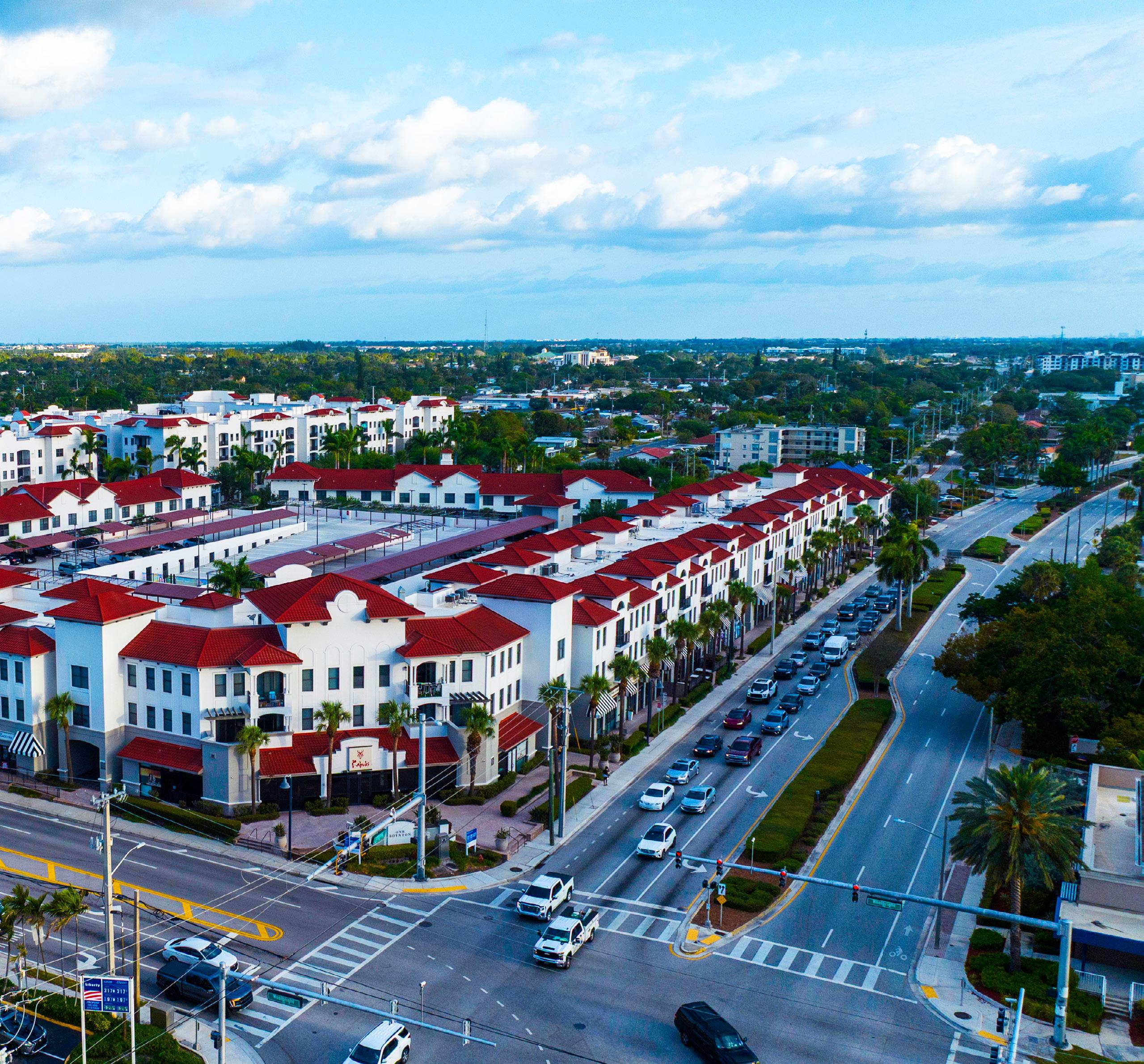
Translating vision into impact requires more than strategy—it requires coordination, accountability, and action. The implementation of Boynton Beach’s Economic Development Plan is designed to operationalize the City’s five guiding principles in a way that delivers measurable progress toward three aspirational goals:
■ Position Boynton Beach as a regional hub for innovation and economic opportunity
■ Become a livable city with vibrant districts, inclusive housing options, and a skilled workforce
■ Foster a collaborative, equitable community that values partnerships and shared prosperity
To achieve this, the City has developed a five-year Implementation Framework that provides a clear roadmap for turning priorities into results. The framework aligns each principle—Downtown & Waterfront Reinvestment, Business Attraction & Retention, Workforce Development & Housing, Placemaking, and Economic Development Marketing—with key initiatives, lead departments, potential partners, estimated timelines, and performance metrics.
This implementation structure is not static; it is a flexible, living tool designed to respond to evolving market conditions, community input, and new opportunities. It enables the City to prioritize resources, monitor progress, and make data-informed adjustments along the way.
Execution will require a cross-sectoral approach. City departments will work closely with regional agencies, private-sector partners, educational institutions, and community organizations to ensure that each initiative reflects a shared commitment to equitable and sustainable economic growth.
Through this collaborative model, Boynton Beach will:
■ Advance catalytic investments in its downtown and waterfront corridors
■ Support the growth and retention of businesses across strategic industries
■ Build a resilient, skilled workforce through targeted training and housing strategies
■ Create vibrant, connected districts that elevate quality of life
■ Amplify the City’s identity through proactive, place-based marketing
By grounding implementation in clear actions, shared accountability, and consistent evaluation, Boynton Beach is not only planning for the future—it is actively building it.
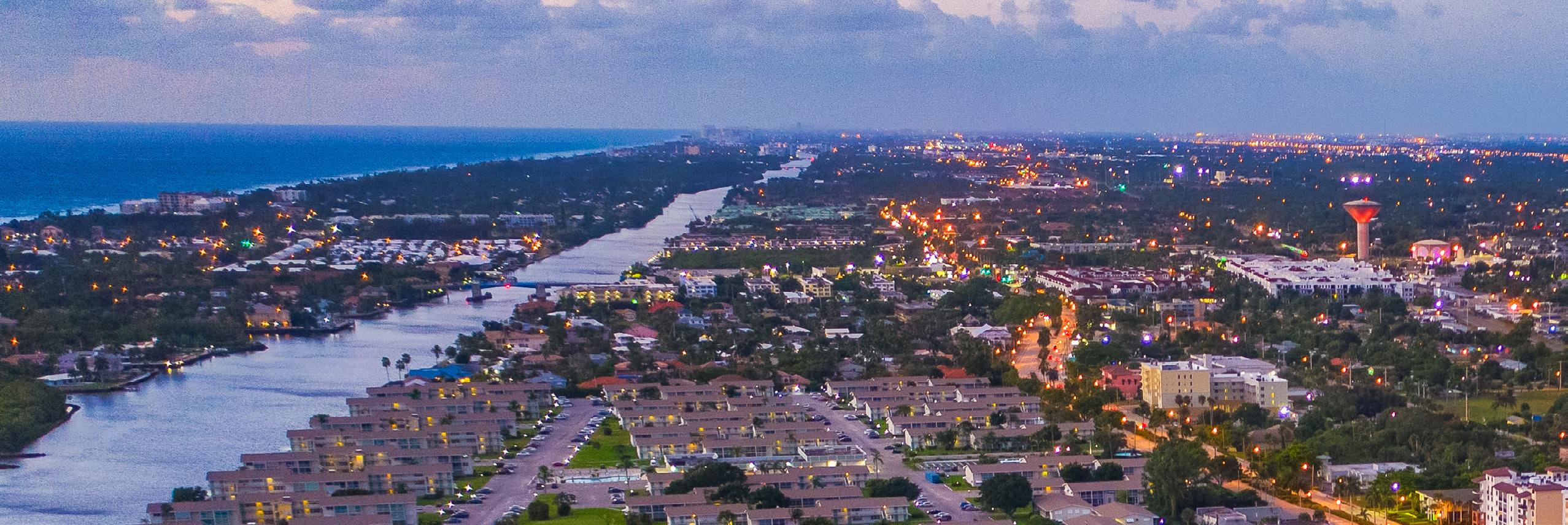
1:1 Develop a phased Town Square improvement plan with landscaping and public art
1:2 Expand civic events, markets, and programming in Town Square
Y1-Y3
Y1–Ongoing
City Planning, CRA, Arts Council
Parks & Rec, Local Nonprofits
1:3 Promote public-private partnerships for infill development Y2–Y5 Economic Dev., CRA, Private Developers
1:4Implement zoning overlays and incentive packages
Amount of redevelopment funds invested to enhance downtown’s public spaces/attractiveness
Annual number of visitors to Town Square, the Marina, and beach-adjacent commercial zones
Increase in residential units within the downtown/waterfront districts 3. Amount of redevelopment funds invested to enhance downtown’s public spaces/attractiveness
Y1–Y3 Planning & Zoning, City Commission 1. Number of net new businesses operating downtown and along waterfront corridors
3. Amount of redevelopment funds invested to enhance downtown’s public spaces/attractiveness
1:5 Recruit dining/hospitality for waterfront corridors Y2–Y5
1:6Conduct a walkability audit and implement signage/ lighting upgrades
1:7 Develop a phased marina expansion and funding strategy
Y1–Y4
Economic Dev., Tourism Council
Public Works, Planning, CRA
Y3–Y5 CRA, Marina Operators, P3 Experts
Number of net new businesses operating downtown and along waterfront corridors
Annual number of visitors to Town Square, the Marina, and beach-adjacent commercial zones
3 .Amount of redevelopment funds invested to enhance downtown’s public spaces/ attractiveness
4. Annual number of visitors to Town Square, the Marina, and beach-adjacent commercial zones

2:1 Focus on Target Industries to align with the city’s key assets. Y1–Ongoing Economic Dev, Business Development Board 5. Job Creation in Targeted Industries
2:2Identify commercial corridors suitable for development and industry expansion.
2:3Create marketing collateral tailored to business attraction
2:4Increase the availability and scope of grant programs for local businesses.
2:5 Develop a platform for matching small businesses with resources
Y1-Y3
Y1-Y3
Economic Dev., Planning & Zoning 3. Business Inquiries or leads generated %
Economic Dev, Marketing
Y1-Y4 Economic Dev, City Commission, Capital Improvement
Y2-Y5
Business Inquiries or leads generated 4 .Number of Entrepreneurs Supported through Programs, Workshops, or Funding Access
Number of incentives or grants awarded 4. Number of Entrepreneurs Supported through Programs, Workshops, or Funding Access
Economic Dev, IT 3 .Business Inquiries or leads generated
4. Number of Entrepreneurs Supported through Programs, Workshops, or Funding Access
2:6Streamline permitting processes for business projects. Y1Ongoing Planning & Zoning, Building
2:7 Develop an incentive framework for high-growth businesses
2:8Facilitate mentorship and Industry networking opportunities
Y2-Y4
number of days for permit approval
Economic Dev, City Commission 1. Number of incentives or grants awarded 5. Job Creation in Targeted Industries
Y1Ongoing Economic Dev, Agencies, SCORE, Chamber
2:9 Identify and map emerging business hubs with targeted industry sectors. Y2-Y5 Business Development Board, Economic Dev.
2:10. Build and expand publicprivate partnerships Y1Ongoing Private Developers, Business Owners, Economic Dev, Agencies, Chamber
Number of Entrepreneurs Supported through Programs, Workshops, or Funding Access
Business Inquiries or leads generated
Job Creation in Targeted Industries
Business Inquiries or leads generated
3:1 Conduct an inventory and assessment of agencies, organizations, and partners
3:2Strengthen relationships with institutions and economic development partners
3:3Facilitate partnerships to expand apprenticeships, internships, and career exposure.
3:4Support the development of targeted training programs in industry sectors to grow a skilled local talent pipeline.
3:5 Develop a comprehensive Housing Affordability Strategy
3:6 Promote and align zoning, planning, and infrastructure strategies to support housing types for all income levels
3:7 Expand homeownership assistance programs
Y1-Y2 Economic Dev
Enrollment or participation in workforce training programs 4.Number of partnerships developed/created
Y1Ongoing Economic Dev, CRA, City Commission, Chamber 2. Enrollment or participation in workforce training programs 4. Number of partnerships developed/created"
Y2-Y5 CareerSource, Business Development Board, Economic Dev, School District 1. Percent of city residents working in the city
Y1Ongoing CareerSource, Business Development Board, Economic Dev, School District 1. Percent of city residents working in the city 2. Enrollment or participation in workforce training programs
Y3-Y5 Capital Improvement, PBC Housing Authority, CRA 3. Amount of public funds allocated toward affordable/ workforce housing
Y2-Y4 Planning & Zoning, City Commission, Economic Dev 3. Amount of public funds allocated toward affordable/ workforce housing 5. Number of new mixed-income or workforce housing units initiated or completed
Y3-Y5 Capital Improvement, PBC Housing Authority, CRA 3. Amount of public funds allocated toward affordable/ workforce housing
5. Number of new mixed-income or workforce housing units initiated or completed
3:8 Partner with local organizations to offer wraparound support services Y1Ongoing Economic Dev 4. Number of partnerships developed/created
3:9 Identify and address barriers to workforce participation
Y1-Y3
CareerSource, Business Development Board, Economic Dev, Chamber 1. Percent of city residents working in the city
4:1 Expand placemaking investment in the CRA Districts and Economic Target Areas.
4:2 Perform a business inventory of the city’s Light Industrial (MI)and Planned Industrial Development (PID) zones
4:3Adopt guiding design principles for the Economic Target Areas, promoting investment activity
4:4Adopt guiding design standards for key corridors that enhance both vehicular and pedestrian streetscapes
4:5 Create a Citywide Pedestrian and Bicycle Connectivity Plan Map
4:6Activate Alleyways and Underutilized Streets with pedestrian-friendly shared spaces
4:7 Develop a Coastal Placemaking Plan to enhance beach access points
4:8 Launch a Year-Round Events Calendar in Key Districts
4:9 Invest in gateways and key entry points into Boynton Beach
4:10. Develop a Citywide Wayfinding and Signage Master Plan with a coordinated signage system
Y1-Y5
Y1-Y2
Y2-Y4
Y2-Y4
Y3-Y5
Y2-Y3
Y3-Y4
Y1-Y5
Y2-Y3
Y3-Y5
CRA, Planning & Zoning, City Commission, Economic Dev 1. Total Projects for public spaces, infrastructure, and urban design
Economic Dev, Business Development Board, Agencies
Public Works, Planning & Zoning, Economic Dev
Public Works, Planning & Zoning, FDOT, Palm Beach County
Public Works, Planning & Zoning, FDOT, Palm Beach County
Public Works, Planning & Zoning, FDOT, Palm Beach County
Public Works, Planning & Zoning, FDOT, Palm Beach County
Economic Dev, CRA, Events
CRA, Planning & Zoning, City Commission, Economic Dev
Public Works, CRA, Planning & Zoning, City Commission, Economic Dev
2. Number of Designated and Activated Placemaking Districts
3. Installation and visibility of district-specific signage
Change in Business Occupancy/ Vacancy Rates in Target Districts
Change in Business Occupancy/ Vacancy Rates in Target Districts
1. Total Projects for public spaces, infrastructure, and urban design
1. Total Projects for public spaces, infrastructure, and urban design
2. Number of Designated and Activated Placemaking Districts
4. Event Attendance and Activation Frequency in Key Districts
1. Total Projects for public spaces, infrastructure, and urban design
2. Number of Designated and Activated Placemaking Districts
4. Event Attendance and Activation Frequency in Key Districts
1. Total Projects for public spaces, infrastructure, and urban design
2. Number of Designated and Activated Placemaking Districts
3. Installation and visibility of district-specific signage"
4. Event Attendance and Activation Frequency in Key Districts
2. Number of Designated and Activated Placemaking Districts
3. Installation and visibility of district-specific signage
1. Total Projects for public spaces, infrastructure, and urban design
2. Number of Designated and Activated Placemaking Districts
3. Installation and visibility of district-specific signage
5:1 Develop and implement targeted branding campaigns that reinforce Boynton Beach as an innovation and growth hub
Ongoing
Dev, City Marketing
5:2 Promote the City’s enhanced development services and streamlined processes to attract investment. Y1Ongoing Planning & Zoning, Economic Dev
5:3Launch marketing campaigns that highlight the City’s Economic Development programs and successes
5:4 Expand the Economic Development website to include a dedicated Workforce Development section.
5:5 Maintain a unified brand identity across all platforms and materials.
5:6Collaborate with local and regional partners to amplify reach and visibility.
5:7Integrate feedback tools to shape strategies.
5:8Use marketing to connect residents and stakeholders to the business community
5:9 Host networking mixers, job fairs, and business workshops
Ongoing
of business relocations, expansions, or investments attributed to marketing initiatives
Number of business relocations, expansions, or investments attributed to marketing initiatives
attendance at Economic Development-hosted events and activations
Ongoing
Ongoing
Ongoing
Ongoing
Ongoing
Ongoing
Dev., Agencies
Dev
Dev
Dev, Events, Chamber
5:10. Coordinate flagship initiatives (Small Business Summit, Small Business Week campaign, Citizens Academy, and Entrepreneurship Academy) Y1Ongoing Economic Dev, CRA, Events, Chamber
and reach of branded marketing collateral produced and distributed
Number of trained Community Ambassadors actively engaged in outreach efforts
digital platforms
attendance at
Development-hosted events and activations
attendance at Economic Development-hosted events and activations
Annual attendance at Economic Development-hosted events and activations
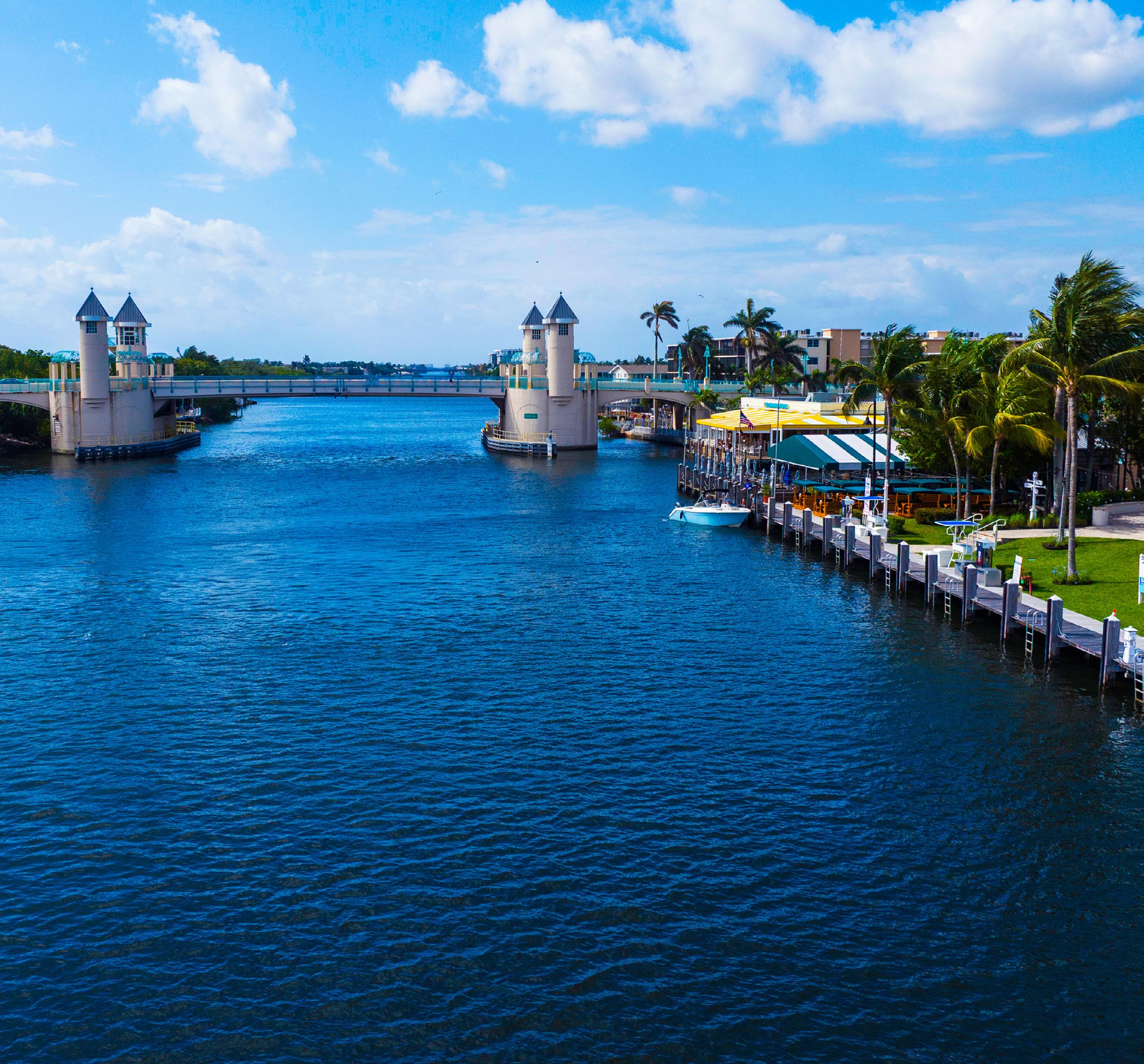
The Economic Development Plan for the City of Boynton Beach is grounded in data-driven analysis and regional context. Its development was guided by a combination of internal expertise and external research, ensuring that the strategies proposed are both locally relevant and aligned with broader economic trends.
To inform this plan, City staff analyzed publicly available data, reports, and strategic documents from a range of federal, state, and regional sources. These materials offered valuable insights into market conditions, demographic changes, infrastructure priorities, industry growth patterns, and community needs—helping to shape a framework that is both forward-thinking and actionable.
Key sources of data and reference included:
■ Business Development Board of Palm Beach
■ Florida Department of Transportation
■ Palm Beach County
■ U.S. Census Bureau
■ Florida Chamber of Commerce
■ Small Business Administration
■ Select Florida
■ Discover the Palm Beaches
■ Palm Beach County Property Appraiser
This integration of regional knowledge and national benchmarks helps ensure that Boynton Beach’s economic development strategy is built on a solid foundation—positioning the City for sustainable

